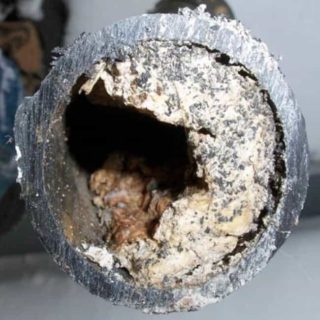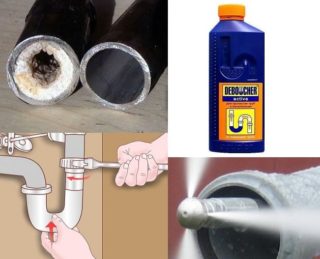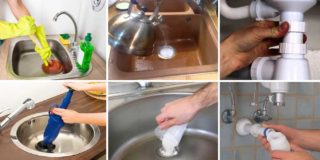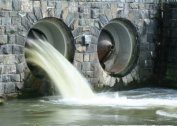Fat deposits in sewer pipes lead to more serious consequences. If small blockages can be eliminated on their own, then only professional services can cope with annual fat deposits. But it's still worth a try. The article describes popular methods for self-dissolving fat in a drainage system.
How does the problem appear
 The main reason is untimely pipe cleaning. With prolonged use of plumbing, the remains of food and detergents in the form of a greasy film settle on the walls of the pipes. The layer grows, the lumen narrows, the water leaves more and more difficult. A person ignores such a problem and continues to use plumbing. As a result, the following problems appear:
The main reason is untimely pipe cleaning. With prolonged use of plumbing, the remains of food and detergents in the form of a greasy film settle on the walls of the pipes. The layer grows, the lumen narrows, the water leaves more and more difficult. A person ignores such a problem and continues to use plumbing. As a result, the following problems appear:
- water leaves very slowly or remains in the sink, toilet bowl;
- the situation has not changed after washing the siphon;
- an unpleasant smell comes from the pipes.
Another reason is pipe features. The inner side of cast iron products has a roughness. Therefore, daily fat accumulates on it. Also, when installing the system, the wrong angle of the drain pipes was chosen. Fat accumulates and turns into a blockage.
How to fix the problem
 There are three ways to clear the sewer. The first is the use of improvised tools. The necessary substances can be found in every home. The instructions are as follows.
There are three ways to clear the sewer. The first is the use of improvised tools. The necessary substances can be found in every home. The instructions are as follows.
- Soda. Pour a glass of baking soda into the sink, pour boiling water. Close with a stopper, leave for 2-3 hours. Then rinse the pipe again with boiling water. Turn on the tap and check the speed of the water leaving. If that doesn’t help, proceed to the next method.
- Soda and vinegar. Pour a glass of soda into the drain, add 3-4 tablespoons of vinegar. A reaction should occur in the form of foaming bubbles. When the quenching of the soda stops, rinse the pipe with hot water. For the best effect, repeat this procedure 2-3 times. Soda and vinegar can only be used to clean plastic and cast iron pipes. It is forbidden to clean the metal, otherwise it will be damaged and rust.
- Coca-Cola or other similar drinks. It is enough to pour 1 liter of soda in the drain, wait a while and rinse the pipe with water. Phosphoric acid effectively dissolves fat. But there is also a minus - dyes. Therefore, it is recommended to use a colorless liquid to clean white plumbing.
- High chlorine products. A good option is whiteness. But it will take from 2 to 3 liters. Pour the whiteness into the drain, rinse with plenty of water.
If alternative methods did not help, you should try the second method - chemicals. It can be tablets, powders, granules, liquids. The following drugs are considered popular drugs.
- "Mole". An effective and inexpensive option. Sold in dry and liquid form. Dry matter has an antibacterial effect. It is important to understand that preparations from different manufacturers differ in dissolution results. The instructions for use are simple - pour or pour the substance into the pipe, wait a few hours, rinse with boiling water.
- "Mister Muscle". Sold in the form of granules and gel. Buyers claim that even with the most persistent fat a thick gel copes well. Instructions - pour half the capacity into the pipe, wait 20 minutes, rinse with boiling water.
- Bagi Pothan. This is the most powerful and effective tool. However, it should be used strictly according to the manufacturer's instructions. Try not to inhale the vapors and open the windows. Pour the contents into the drain, pour a glass of boiling water as quickly as possible. Leave as it is for several minutes, rinse again with hot water.
To cope with persistent blockages, the third method will help - mechanical. It includes the use of:
- plunger - just attach to the hole, perform translational movements to create pressure in the pipe;
- plumbing cable - lower into a pipe, rotate until it pushes through the blockage;
- steel tapes - push into the pipe, eliminate the blockage, rinse the remains with hot water.
Experts advise using the mechanical method simultaneously with chemical preparations. Hand tools only eliminate blockage, but do not disinfect pipes.
If for some reason it was not possible to cope with the fat in the sewers on our own, you should contact the professionals. Today they use hydrodynamic devices that instantly remove all layers.
What to do to prevent a problem
 Observe preventive measures. In case of difficult water withdrawal, use alternative methods, chemical preparations in the form of a gel and granules. Treat pipes with folk remedies once a week, with chemicals - once every 3 months.
Observe preventive measures. In case of difficult water withdrawal, use alternative methods, chemical preparations in the form of a gel and granules. Treat pipes with folk remedies once a week, with chemicals - once every 3 months.
Here are a few more preventative measures.
- Wash dishes with warm water. Cold water contributes to the rapid layering of fat on the walls of pipes. After washing the dishes, pour 1 liter of hot water into the sink. It is better to clean the dishes over the basin, and then drain the used water into the toilet. It, in turn, is treated with a special gel.
- Do not pour leftovers into the sink or toilet. It is enough to throw them into the bin, recycle them in the disposer. Also close the sink drain with a special grill.
- Protect plumbing from small children. Often, kids throw various toys and things into the toilet or sink.
Many people prefer to install a household fat separator. The device filters waste water from debris and dirt particles, separates and retains fat.


